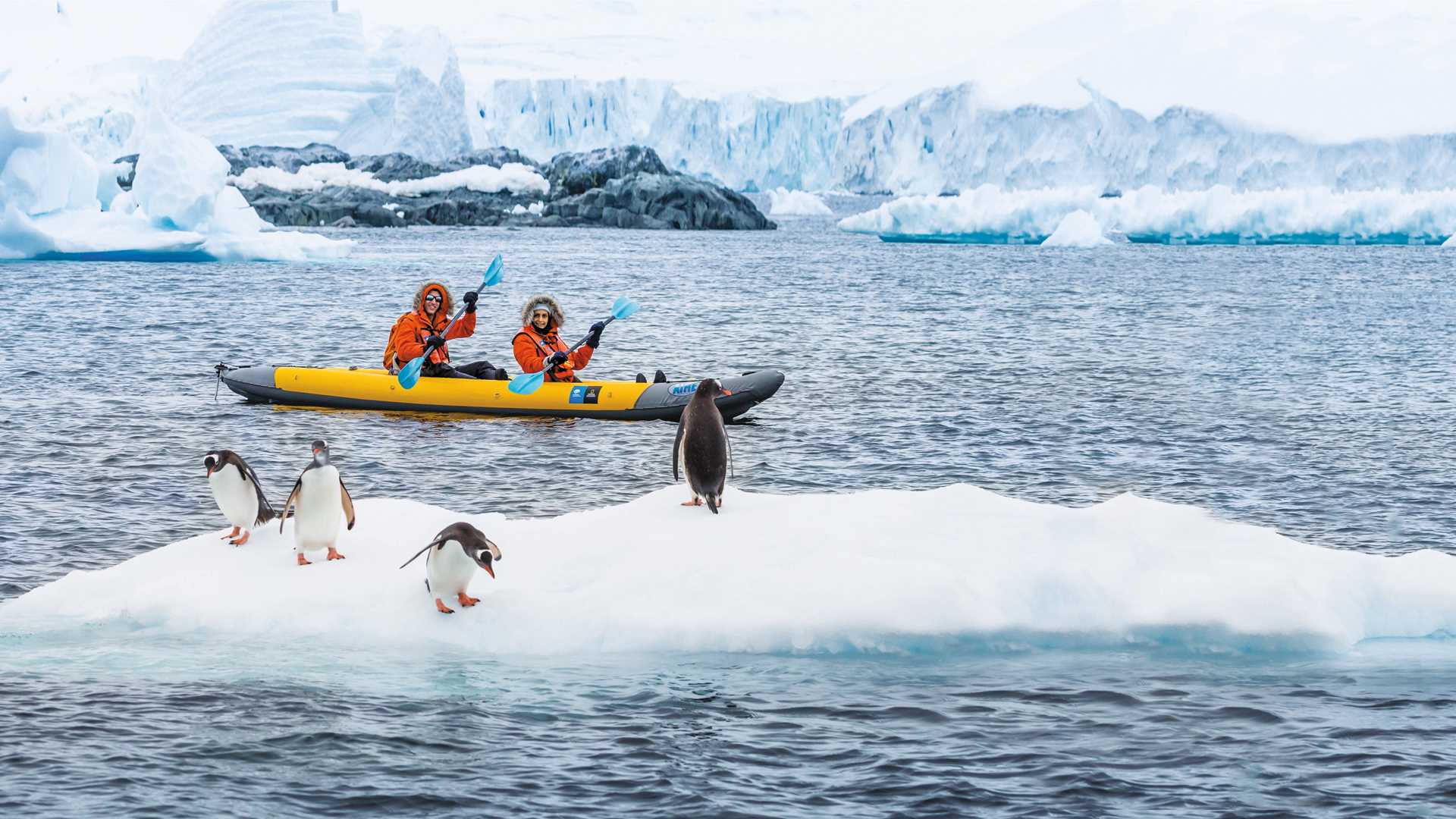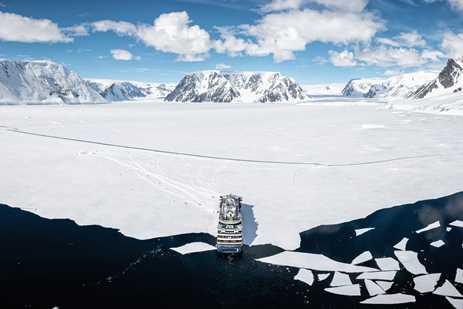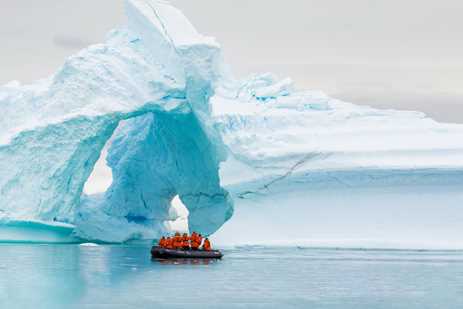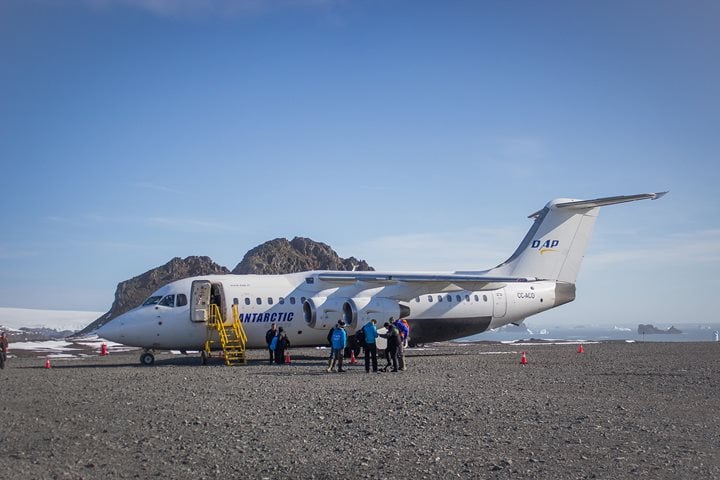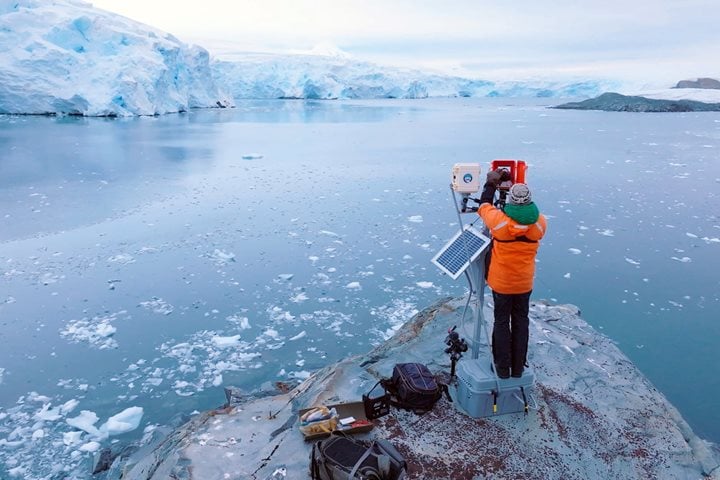Call +1.800.397.3348 or contact your travel advisor
Traveling to Antarctica on an expedition cruise is a bucket-list experience. But kayaking in Antarctica takes it up a notch, turning your trip into the adventure of a lifetime.
There is no better way to immerse yourself in this dynamic, strikingly beautiful kingdom of ice than by exploring up close at wave and sea-life level. It may sound intimidating at first, but know that even the most novice of kayakers can partake in the experience.
Here, James Hyde, an expedition leader and naturalist with National-Geographic-Lindblad Expeditions—the pioneers of Antarctic exploration—helps answer top questions about paddling among penguins and ethereal icebergs.
Kayaking in Antarctica
Going ocean kayaking in a two-person inflatable kayak represents freedom, a chance to explore the region’s pristine waters and otherworldly shorelines at your own pace, paddling where your curiosity takes you.
It puts you directly in the heart of this wild terrain and Hyde says that guests inevitably look forward to kayaking among icebergs (at a safe distance) and watching nearby penguins porpoising in and out of the water or waddling along the beach.
You'll also enjoy other indelible experiences from the vantage point of your kayak, like witnessing seabirds plunging into the waves nearby to catch fish, spotting seals hauled-out on ice floes or even getting a glimpse of feeding whales.
It’s important to know though that sea kayaking in Antarctica is heavily regulated in terms of how close you can get to wildlife, and you can only experience it with an IAATO (International Association of Antarctica Tour Operators) operator like National Geographic-Lindblad Expeditions.
Of course, before you ever step foot in that kayak, you first need to prepare to get yourself to the seventh continent. Start your research by learning how to travel to Antarctica from your hometown, and then from there make sure you’re up to date on your Antarctica passport requirements.
What’s It Like to Kayak in Antarctica?
Kayaking in Antarctica gives guests a chance to experience the continent’s unique beauty at eye level, instead of from above—looking over the railing of a cruise ship.
Being on the water is full sensory immersion: the crisp air on your face; the brine of the sea and the gentle sloshing of the waves against your kayak; the stark lines of iceberg and glacier ice etched against the deep-blue sky; untrammeled mountain ranges stretching across the horizon, and the opportunity to get close to wildlife—to hear the seals barking, smell the unforgettable odor of a teeming penguin rookery, and see the thousands of birds raising their young, hunting, and playing.
Kayaking excursions with National Geographic-Lindblad Expeditions take place in deep water, explains Hyde, so the inflatable boats don’t bottom out. The expedition team will also choose an area with stable ice structures to explore and scenic mountains nearby, plunging to the sea or rising on the skyline.
One place that ticks all these boxes is the amphitheater of Paradise Harbour, on the Antarctic Peninsula. Sailing here provides guests the chance to experience its sheltered and famous topography, as well as to see penguins and whales. “It’s a knockout,” says Hyde.
Depending on what you want to see in terms of ice formations and wildlife, you’ll want to come either earlier or later in the season. As you plan your visit, be sure to read up on the best times to go to Antarctica.
What to Expect: Kayaking in Antarctica
Antarctic Expedition Cruises with Kayaking
Lindblad Expeditions pioneered sea kayaking from expedition ships in polar waters and developed a propriety staging platform that allows the expedition team to deploy guests in kayaks in incredibly remote locations—without a reliance on beaches, docks or other infrastructure.
The polar ships in the National Geographic-Lindblad Expedition fleet are all equipped with 24-35 stable double kayaks, enough so that every guest aboard who is interested will have the chance to paddle among penguins.
While other travel companies have incorporated this kayaking idea, keep in mind that not everyone offers it, so you’ll want to check before you book. Those that do offer it may only have a handful of kayaks aboard, meaning you might never get an opportunity during your voyage depending on how many other passengers want to try it as well.
How Does It Work?
After kitting up, guests head down to the kayak launch in the belly of the ship. National Geographic-Lindblad Expeditions makes getting into and out of the kayaks a snap: the kayaks launch using a “metal beach” strung between two Zodiac boats, letting guests step into the kayaks from a zero-entry pool, assisted by staff and crew.
Your guides will then outline the boundaries of the free-roaming paddling area as well as potential hazards to avoid (currents, unstable icebergs, shallow water, etc.), keeping a watchful eye on guests from Zodiacs circling nearby, but never so close as to be obtrusive.
Guests are free to pair up with friends or family in the two-person kayaks and explore on their own, although there are also occasionally guided outings in which expedition staff will kayak with or alongside guests, says Hyde.
At the end of the allotted time, or if conditions deteriorate, the safety Zodiacs will alert kayakers to head back to the metal platform to disembark.
What Kayaking Gear Is Provided?
National Geographic-Lindblad Expeditions provides all the equipment needed to kayak, including proprietary, inflatable two-person expedition kayaks, and paddles (there’s no spray skirt, as these are sit-on-top kayaks).
Guests are encouraged to wear suitably warm clothing as their underlayers and to bring their own waterproof pants, but they'll receive the beloved, waterproof orange expedition jacket all guests of National Geographic-Lindblad Expeditions get when they come on board the cruise ship. (Dry suits are not provided.) To select which clothing to bring in general, consult this handy Antarctica Packing Checklist.
How Much Does It Cost to Go Kayaking in Antarctica?
The amount you pay to kayak in Antarctic waters will depend on the cruise operator. Some companies, like National Geographic-Lindblad Expeditions, include kayaking in their overall Antarctica cruise prices. However, some companies do charge a separate fee, which can run as high as $800-$1200, to enjoy this activity. Operators that charge extra for kayaking may also require advanced reservations. Be sure to ask about these details when booking your expedition so you don’t find yourself without a seat after you get on board.
What Are the Conditions Like While Kayaking in Antarctica?
There are many protected waterways in the region which provide tranquil environments, ideal for an idyllic paddle. Be assured that veteran travel operators like National Geographic-Lindblad Expeditions won’t send you out kayaking on stormy or otherwise unsettled days—only on mild, sunny or partly cloudy days with little wind. During the prime visitation months of November through March, expect daytime temperatures from 24 to 40 degrees F.
How Many Times Can I Go Kayaking?
That will depend on the travel operator you choose. For example, on a 14-day National Geographic-Lindblad expedition that has favorable weather, you might expect to kayak once or twice, for an hour or so each time.
If kayaking options are limited by weather conditions, there are plenty of other activities to engage adventurous travelers, including Zodiac rides among towering icebergs or hikes on the spectacular coastline.
If the weather is too poor even for those activities, choose from an array of immersive activities back on board your ship, like informative lectures on topics related to Antarctica, yoga, fine dining, spa treatments, and guided undersea ROV exploration.
What Will I See While Kayaking?
“Most people come to Antarctica for the penguins,” says Hyde. “And they are fabulous creatures. They’re very charming and have so much character.” But, he adds, “The adage is that you come for the penguins, and you come back for the ice,” speaking to the raw power of Antarctica’s landscapes to enchant visitors, beyond the charismatic wildlife.
When out among the ice floes and bergs, you’re kayaking in a “floating sculpture garden that’s always changing and will never be the same twice,” says Hyde. “You never thought you could perceive so many shades of blue and white.”
In all his years guiding expeditions in Antarctica, Hyde has also seen seals and whales while kayaking, as well as seen whales swim under kayakers (himself included), though such sightings are rare—yet inevitably “life-changing.”
Should Photographers Kayak in Antarctica?
While diehard photographers may relish the sea-level perspective, they may find themselves frustrated by the rocking of the kayaks as well as concerned about dropping an expensive camera into the drink. Better perhaps is to trade some image quality for convenience and shoot with a smartphone.
This guide to Antarctica photography has more expert tips to ensure you return home with spectacular images.
What Guests Think of Kayaking in Antarctica
“People often comment about how peaceful it is, and how much they enjoy being out on their own completely away from any semblance of civilization,” says Hyde. Guests love the freedom to roam, the vastness of the landscape, and the quiet, almost eerie silence in a part of the world where there aren’t even jets flying over. Ask anyone who has kayaked there and odds are they'll say it was the experience of a lifetime.
Another aspect of sea kayaking in Antarctica that makes all the travel worth it is experiencing firsthand the ethereal and ever-changing sea ice, right from ocean level.
Says Hyde, “Guests really enjoy getting in the brash ice”—a mixture of small ice fragments floating on the surface—and hearing the unique, dynamic sounds it makes, like the glass-like tinkling as you paddle through and “ice crispies,” the “snap, crackle, pop” as the brash ice releases trapped gas.
Do I Need to Be an Experienced Kayaker?
The kayak outings on an Antarctica voyage with National Geographic-Lindblad Expeditions might be thought of as “low octane”: accessible, low stress, and low commitment, says Hyde. “We never require people to have lessons or pre-requirements—it’s open to everybody,” he says. “And we have very safe, very stable kayaks.”
In his eight guiding expeditions in Antarctica, Hyde has never once seen anyone fall into the sea or experience any other emergency—even novice kayakers.
Is Kayaking in Antarctica Safe?
Yes, kayaking in Antarctica is safe: National Geographic-Lindblad Expeditions only sends guests out kayaking on low-wind (2 knots or less), low-chop days, and the boats are essentially uncapsizable. “I’ve put a dry suit on and tried to tip them over—and it’s not easy,” reassures Hyde.
What Happens If I Fall in?
Your first line of safety will be your lifejacket and the Emergency Position Indicating Radio Beacon (EPIRB) that activates the second it gets wet or you push the button, sending a screeching alarm via radio signal to the expedition cruise ship and nearby Zodiacs, which are waiting to roar in and pluck kayakers out of the water.
Whether you’re an avid kayaker or have never picked up a paddle, kayaking in Antarctic waters is a must-do for every traveler to the seventh continent. It promises to be an unforgettable highlight of your voyage, providing a unique perspective of polar geography and wildlife and connecting you more deeply to this exceptional, ever-changing part of the planet.

